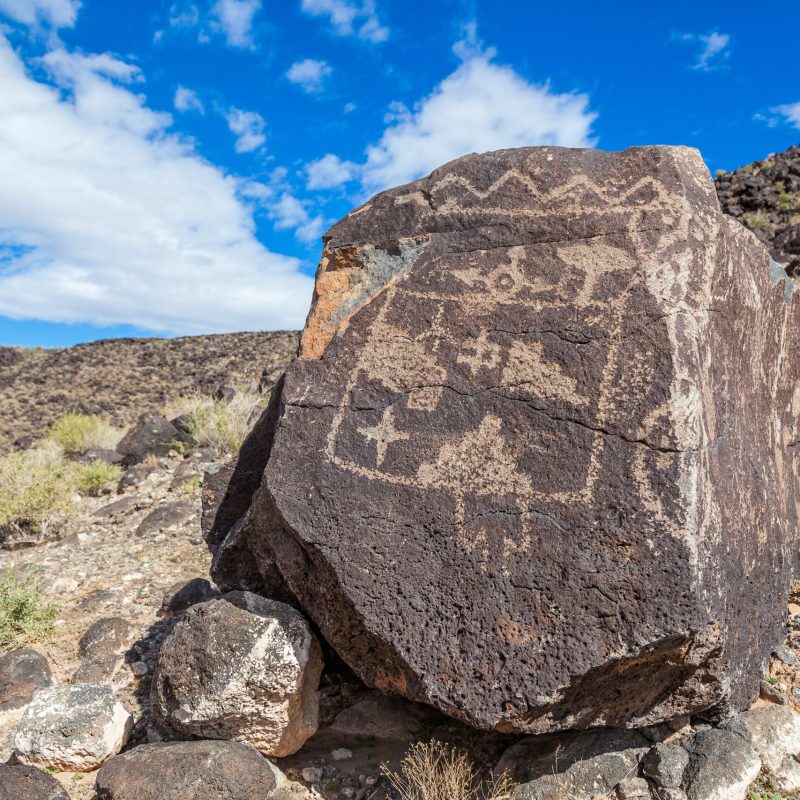
Archeologists study them, and tourists marvel at them. Petroglyphs are some of our world’s most ancient art, etched into caves, canyons, hillsides, and boulders by indigenous people hundreds, and sometimes thousands, of years ago. Some depict animals or people, while the meanings of other symbols are less clear.
Videos by TravelAwaits
Here are some of the most spectacular spots in America to see these mysterious markings. Many petroglyphs are located in parks designed to protect them. Remember, if you go, be respectful — leave nothing behind, take nothing with you, and don’t touch — to help keep these historic sites beautiful for generations to come.

Nine Mile Canyon, Utah
There’s a reason this place is often called “the world’s longest art gallery.” The 46-mile-long canyon is filled with rock art created by the Archaic, Fremont, and Ute peoples.
This amazing spot is located about 2 hours from Salt Lake City, and it makes a perfect day trip. It is, however, quite remote. Make sure to gas up and bring plenty of water and snacks with you. While you can easily see the area’s petroglyphs from your car, it’s worthwhile to park and take a closer look during your canyon cruise. There’s no cost to access the site.

Canyonlands National Park, Utah
Horseshoe Canyon, a part of Canyonlands National Park, is a marvel that is home to both petroglyphs and pictographs (painted images). The Great Gallery — Horseshoe Canyon’s most impressive sight — features life-size figures and amazing designs in a display that’s more than 200 feet long. Believed to have been created by hunter-gatherer tribes thousands of years ago, it’s a dazzling display of rock art.
Getting to the canyon, however, is tough: It’s a long drive on a dirt road to reach the trailhead (3 hours and 30 minutes from Moab, Utah, the nearest city), and the road can be impassable during storms. From the trailhead, you must hike 7 miles to the Gallery and back. Do not attempt the hike in the summer, since temperatures can easily reach well over 100 degrees, and there are no services or amenities. Yes, it’s a daunting journey. Yes, you will need to plan ahead to get there. And yes, it’s completely worth it.

Petroglyph National Monument, New Mexico
Located in Albuquerque, New Mexico, Petroglyph National Monument was set up to protect one of the largest ancient art sites in North America. Scientists estimate that there may be more than 25,000 individual etchings in the park; these etchings are thought to be the handiwork of the ancestors of the Pueblo people.
Start your day at the visitor center to learn more about these people and their art, and then hit the trails. There are four hikes available, ranging in both length and difficulty. Three of them will allow you to get up close and personal with hundreds of petroglyphs. The park is open year-round, and admission is free.

El Morro National Monument, New Mexico
El Morro National Monument was once a stopover spot of sorts, a place where desert travelers could find shelter, food, and a place to rest. Thousands of years ago, the Zuni people made this spot in the sandstone bluffs their home; some of their pueblos and other structures still remain, and so do the images they carved into the surrounding stones. That art is still vivid and visible, but centuries later, Spaniards also carved their names — and the dates they passed through — into the soft rock. It’s fascinating to see the Zuni markings alongside the younger European ones.
This magical spot is located about 2 hours west of Albuquerque. There are camping and picnic facilities, and admission is free.

Tutuveni Petroglyph Site, Arizona
The Tutuveni Petroglyph Site is sacred to the Hopi people. The Hopi word Tutuveni means “Newspaper Rock”; the petroglyphs here tell the stories of ceremonial pilgrimages to the Grand Canyon. The site sits along a 100-mile trail from the Hopi mesas to the Canyon, and the faithful recorded information about their journeys on the rocks.
Tutuveni is home to more than 5,000 etchings, and 60 percent of them are on one boulder (Boulder 48). The site has been vandalized over the years, and it is now protected by a fence and surveillance cameras in an effort to preserve the petroglyphs.
Tutuveni is located on a Hopi reservation near Tuba City, Arizona. A visit to the reservation is free.

Valley Of Fire State Park, Nevada
Only about an hour northwest of the bright lights of Las Vegas, Valley of Fire State Park is a prime spot to view petroglyphs. Scientists say that the art here is more than 2,000 years old, and its canvas is dramatic red Aztec sandstone. Carved by members of the Basketmaker culture and then the early Pueblo people, the images depict hunting and gathering.
Hiking at Valley of Fire is easy, and the picturesque payoff is well worth the effort. The Mouse’s Tank Trail is especially stunning — and only about a mile long. The park offers camping areas and other amenities; admission costs $10 per vehicle.

Puako Petroglyph Archaeological Preserve, Hawaii
If you’re on Hawaii’s Big Island, take a break from the beach and channel your inner Indiana Jones at the Puako Petroglyph Archaeological Preserve, just north of Kona. Here, ancient islanders carved thousands of images into the lava rocks. The sheer size and scope of the site are apparent as you hike the fields.
Word to the wise: Bring plenty of water, put on sunscreen before you go, and throw on a hat for good measure. This part of the island is arid, ferociously sunny, and unforgiving to those who don’t take the proper precautions. The area is free to the public.

Millstone Bluff Archaeological Area, Illinois
This little-known location in southern Illinois is rich in ancient history and art. Located in the Shawnee National Forest, the Millstone Bluff Archaeological Area is on the National Register of Historic Places for its archeological significance. Frequented by the Mississippi and Woodland tribes, the bluff was once home to a sizeable village. The village was abandoned at some point; scientists still don’t know why. Today, an ancient burial ground and several striking petroglyph panels still exist. The National Park Service has installed interpretive signs along the mile-long hike, so visitors can easily spot the thunderbirds and other figures etched in the stones.

Washington State Park, Missouri
Only about an hour southwest of Saint Louis sits a treasure trove of ancient petroglyphs. They’re located in Washington State Park and are easy to view from the observation decks designed to protect them. Here, you’ll see the largest number of ancient rock carvings discovered in the state of Missouri; they were created by people who lived in the area 1,000 years ago. Thunderbirds, footprints, and human figures are all discernible, along with other symbols and scenes.
The park offers guided tours of the petroglyphs on Saturday afternoons from Memorial Day to Labor Day; private tours can also be arranged. Admission is free, and there are cabins for rent and camping facilities on-site.

Olympic National Park, Washington
Along the rugged Pacific coast, one can spot carved orcas, moons, suns, and even a sailing ship set in stone. The Wedding Rocks petroglyphs, located on the Ozette Trail inside Olympic National Park, are difficult to reach, but they’re worth the trek. Left behind by the Makah people who settled here, these 40 gorgeously rendered images are 300 to 500 years old.
To reach them, you’ll need to hike 9 miles along the rocky coastline. It’s important to time your trip correctly so that you reach the area at low tide. All that said, this is a stunning hike with an incredible payoff in terms of natural and man-made beauty. Access to the park is free.

Roche-A-Cri State Park, Wisconsin
About 30 miles north of the Wisconsin Dells, in the small town of Friendship, Wisconsin, sits an ancient collection of rock art carved into a dramatic 300-foot outcrop. The Roche-a-Cri (taken from the French phrase “crevice in the rock”) petroglyphs are located inside a state park that was established to protect them back in 1948. While you can climb the stairs to the top of the cliff for sweeping views, the petroglyphs are carved into the base and are easy to view. People believed to have been ancestors of the Ho-Chunk tribe etched birds, canoes, and geometric designs deep into the rock. It’s thought that this spot held special meaning — perhaps as a message post for travelers — since the outcrop can be spotted for miles.
You do need to purchase a sticker if you’re driving in; vehicles with out-of-state plates can access the park for $11.
Photo Credit: sumikophoto / Shutterstock
Photo Credit: turtix / Shutterstock

